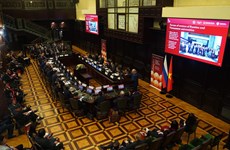Urbanisation not parallel to quality of life: Official
 At the workshop (Photo: VietnamPlus)
At the workshop (Photo: VietnamPlus) Hanoi (VNA) – Urbanisation and urban advancement have created favourable conditions for socio-economic development. However, urban upgrade targets have only been set for land and population increase instead of actually designing improved urban quality of life. Air, water and noise pollution occur in new urban areas at alarming levels, leaving some areas vulnerable to climate change.
The topic was mentioned in a workshop featuring the development of new models and transition to green and sustainable urban economy, as part of the Vietnam Urban Sustainable Development Forum co-hosted by the Party Central Committee’s Economic Commission and the Construction Ministry on June 17.
Expanding economic space
At the event, Deputy Prime Minister Le Van Thanh said after over 35 years of renewal policy, Vietnam’s urban system has developed strongly in terms of quantity and quality.
The country has so far recorded 869 urban areas. The urban economy has in fact been growing by 12-15% annually, or 1.5-2 times the country’s average, making up about 70% of the gross domestic product.
According to him, a number of civilised and modern urban areas, especially sci-tech and education-training centres, have sprung up in metropolises such as Hanoi and Ho Chi Minh City. This is laying an important foundation for Vietnam’s urban development in the coming time. So far, policies on urban planning and development, housing and real estate market have been rather complete and concerted.
Deputy head of the Economic Commission Dr. Nguyen Duc Hien said urbanisation has made it easier to develop infrastructure, human resources, industries and services. This serves to attract more foreign direct investment and promote economic structure transition to industrialisation, improving output and economic growth quality. New models have also appeared, such as green, smart, ecological, industrialised-commercial-service urban development.
Such models have contributed to promoting the switch to green urban economic growth while improving competitiveness, poverty reduction and resilience to climate change, he said.
Only targets of enhanced land, population met
However, Hien admitted that green, sustainable and smart urban development models remain less popular and less attention has been paid to improving urban quality.
Only about 26% of the urban areas nationwide have issued regulations on the management of architectural planning. In many localities, air pollution tends to be worse in both scale and level. Particularly in major cities, water and noise pollution are at alarming levels.
He pointed to a fact that around 300 coastal urban areas will be hard hit by climate change while nearly 140-150 others in mountainous areas will be affected by landslide, flash floods and drought. Areas with growing urbanisation in recent years are under the threat of climate change.
Nationwide urban economic growth mostly relies on five centrally-run cities, two of those are Hanoi and Ho Chi Minh City, he added.
Completing legal framework needed
Hien revealed that the Economic Commission has submitted a Project to the Politburo for the issuance of the Resolution No.06-NQ/TW dated January 24 on the planning, building, management and sustainable development of Vietnam’s urban areas till 2030 with a vision to 2045. Accordingly, the Resolution will lay an important political foundation to work out new mechanisms and policies, thus creating a driving force to develop urban areas, making important contributions to rapid and sustainable socio-economic development.
Specifically, the Resolution has outlined opinions and targets for Vietnam’s sustainable urban development together with key tasks and measures. Some of these are completing mechanisms, policies and standards that are suitable with regions, mountainous and highland areas, and those with importance to national defense-security. Also included are urban areas with many historical, cultural heritages and landscapes in need of preservation.
About renewing financial mechanisms and policies for urban economic development, Hien said focus will be placed to improving the efficiency of using land, and sustainably tapping cultural and historical works. Public areas such as pavements, hospitals, universities, colleges, research establishments, logistic centres, shopping malls, wholesale and wet markets are also part of the plan.
Attention will be paid to developing urban, advanced and strategic industries, digital, circular, shared, night-time, tourism and sport economies.
In order to achieve the targets set, taxation and fee policies related to real estate need to be revised to encourage the effective use of housing and land while legal corridors must also be completed, Hien said./.













